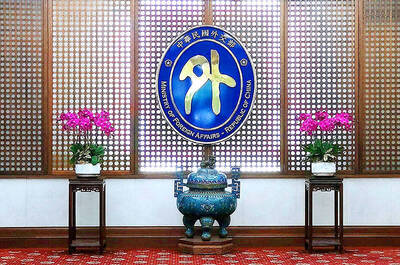Nearly 13 hectares of land in the Matsu Islands are to be set aside for firefly conservation, becoming the first habitat to be preserved for an island insect species.
The decision comes a decade after two new species of firefly were identified by researchers at the Council of Agriculture’s Endemic Species Research Institute.
Led by institute entomologist Ho Jen-zon (何健鎔), the team spent two years studying the species after local residents noted their distinct behavior.

Photo courtesy of Beigan Township
While male fireflies usually emit light to attract females, in the Matsu species, the flightless females emit a steady light while on the ground to attract flighted males, typically between 7pm and 8pm.
The females also use the light as protection, emitting a blinking pattern while crawling or protecting their eggs as a warning to predators.
The team named the first species Rhagophthalmus beigansis after Beigan (北竿), where it is exclusively found. The second, found in Juguang (莒光), was named Rhagophthalmus giallolateralus.
Ho, who passed away in 2018, published the results of the research in the April 2012 issue of Zootaxa.
Only about 200 of the rare fireflies are left in the wild, prompting a collaboration between the Lienchiang County Government and the Forestry Bureau to set up a conservation area on Beigan, Dongju (東莒) and Xiju (西莒) islets.
All fireflies are affected by human encroachment, light pollution and pesticides, but these species are especially vulnerable as they live on the ground, Forestry Bureau Conservation Division Director Shih Chih-ching (石芝菁) said on Saturday.
The county government is therefore taking the initiative to designate a critical habitat to protect the insects, Shih said.
Residents are to be afforded 60 days notice, after which the county government would implement conservation measures, such as restrictions on land use and light pollution, she said.
Conservation areas have historically been established for the benefit of mammals, with few exceptions for insects, most notably the critical habitat designated in 2000 for the broad-tailed swallowtail butterfly, Shih said.
However, the Matsu firefly habitat would be the first to be established for an island-dwelling insect, she said.

ALIGNED THINKING: Taiwan and Japan have a mutual interest in trade, culture and engineering, and can work together for stability, Cho Jung-tai said Taiwan and Japan are two like-minded countries willing to work together to form a “safety barrier” in the Indo-Pacific region, Premier Cho Jung-tai (卓榮泰) yesterday said at the opening ceremony of the 35th Taiwan-Japan Modern Engineering and Technology Symposium in Taipei. Taiwan and Japan are close geographically and closer emotionally, he added. Citing the overflowing of a barrier lake in the Mataian River (馬太鞍溪) in September, Cho said the submersible water level sensors given by Japan during the disaster helped Taiwan monitor the lake’s water levels more accurately. Japan also provided a lot of vaccines early in the outbreak of the COVID-19 pandemic,

The Ministry of Foreign Affairs (MOFA) yesterday voiced dissatisfaction with the Comprehensive and Progressive Agreement for Trans- Pacific Partnership (CPTPP), whose latest meeting, concluded earlier the same day, appeared not to address the country’s application. In a statement, MOFA said the CPTPP commission had "once again failed to fairly process Taiwan’s application," attributing the inaction to the bloc’s "succumbing to political pressure," without elaborating. Taiwan submitted its CPTPP application under the name "Separate Customs Territory of Taiwan, Penghu, Kinmen and Matsu" on Sept. 22, 2021 -- less than a week after China

Kaohsiung Mayor Chen Chi-mai (陳其邁) on Monday announced light shows and themed traffic lights to welcome fans of South Korean pop group Twice to the port city. The group is to play Kaohsiung on Saturday as part of its “This Is For” world tour. It would be the group’s first performance in Taiwan since its debut 10 years ago. The all-female group consists of five South Koreans, three Japanese and Tainan’s Chou Tzu-yu (周子瑜), the first Taiwan-born and raised member of a South Korean girl group. To promote the group’s arrival, the city has been holding a series of events, including a pop-up

A home-style restaurant opened by a Taiwanese woman in Quezon City in Metro Manila has been featured in the first-ever Michelin Guide honoring exceptional restaurants in the Philippines. The restaurant, Fong Wei Wu (豐味屋), was one of 74 eateries to receive a “Michelin Selected” honor in the guide, while one restaurant received two Michelin stars, eight received one star and 25 were awarded a “Bib Gourmand.” The guide, which was limited to restaurants in Metro Manila and Cebu, was published on Oct. 30. In an interview, Feng Wei Wu’s owner and chef, Linda, said that as a restaurateur in her 60s, receiving an